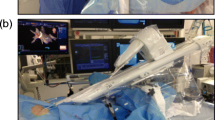Abstract
Introduction: Atrial fibrillation has been shown to initiate from triggers within pulmonary veins. Several studies have documented that electrical isolation of those triggers can lead to maintenance of sinus rhythm. The complication of pulmonary vein stenosis has limited the utility of delivering ablation energy within the pulmonary vein. We utilize a focused ultrasound catheter ablation system for delivery of transmural ablation lines proximal to the pulmonary vein ostium.
Methods: Nine dogs (weight 30–39 kg) were anesthetized and ventilated. Through a transseptal approach, pulmonary veins were engaged with the focused balloon ultrasound catheter. Ultrasound power was delivered at 40 acoustic watts outside the pulmonary vein ostium, focused 2 mm off the balloon surface, with a depth of approximately 6 mm, for 30–120 seconds. Following ablation, lesions were histopathologically analyzed.
Results: Of nine animals studied, fourteen pulmonary veins were ablated. We found successful delivery of near circumferential and transmural ablation lines in 6/14 pulmonary veins. In each of the six circumferential ablations, successful alignment of the ultrasound transducer along the longitudinal axis of the parabolic balloon occurred. The final four ablations were conducted with an enhanced catheter design that assured axial alignment. Of these ablations, all four were circumferential. The remaining 8 pulmonary veins had incomplete delivery of lesions. In each of these veins the ultrasound transducer was misaligned with the balloon axis when therapy was delivered.
Conclusion: Focused ultrasound ablation is a new means of performing pulmonary vein isolation. This method provides delivery of lesions outside the vein, limiting the risk of pulmonary vein stenosis for the treatment of atrial fibrillation.
Similar content being viewed by others
References
Haissaguerre M, Jais P, Shah DC, et al. Spontaneous initiation of atrial fibrillation by ectopic beats originating in the pulmonary veins. N Engl J Med 1998;339:659–666.
Chen S, Hsieh M, Tai C, et al. Initiation of atrial fibrillation by ectopic beats originating from the pulmonary veins. Circulation 1999;100:1879–1886.
Haissaguerre M, Shah D, Jais P, et al. Electrophysiological breakthroughs from the left atrium to the pulmonary veins. Circulation 2000;102:2463–2465.
Jais P, Haissaguerre M, Shah D, et al. A focal source of atrial fibrillation treated by discrete radiofrequency ablation. Circulation 1997;95:572–576.
Oral H, Knight B, Tada H, et al. Pulmonary vein isolation for paroxysmal and persistent atrial fibrillation. Circulation 2002;105:1077–1081.
Pappone C, Rosanio S, Oreto G, et al. Circumferential radiofrequency ablation of pulmonary vein ostia. Circulation 2000;102:2619–2628.
Yu W, Hsu T, Tai C, et al. Acquired pulmonary vein stenosis after radiofrequency catheter ablation of paroxysmal atrial fibrillation. J Cardiovasc Electrophysiol 2001;12:887–892.
Robbins IM, Colvin EV, Doyle TP, et al. Pulmonary vein stenosis after catheter ablation of atrial fibrillation. Circulation 1998;98:1769–75.
Pappone C, Oreto G, Lamberti F, et al. Catheter ablation of paroxysmal atrial fibrillation using a 3D mapping system. Circulation 1999;100:1203–1208.
Natale A, Pisano E, Shewchik J, et al. First human experience with pulmonary vein isolation using a through-the-balloon circumferential ultrasound ablation system for recurrent atrial fibrillation. Circulation 2000;102:1879–1882.
Lemery R, Veinot J, Tang A, et al. Fiberoptic balloon catheter ablation of pulmonary vein ostia in pigs using photonic energy delivery with diode laser. PACE 2002;25:32–36.
Tanaka K, Satake S, Saito S, et al. A new radiofrequency thermal balloon catheter for pulmonary vein isolation. JACC 2001;38:2079–2086.
Kanagaratnam L, Tomassoni G, Schweikert R, et al. Empirical pulmonary vein isolation in patients with chronic atrial fibrillation using a three-dimensional non-fluoroscopic mapping system: long-term follow-up. PACE 2001;24:1774–1779.
Zimmer JE, Hynynen K, He DS, et al. The feasibility of using ultrasound for cardiac ablation. IEEE Trans Biomed Eng 1995;42(9):891–897.
Lesh MD, Diederich C, Guerra G, et al. An anatomic approach to prevention of atrial fibrillation: Pulmonary vein isolation with through-the-balloon ultrasound ablation (TTB-USA). Thorac Cardiovasc Surg 1999;47(Supplement):347–351.
Schweikert R, Saad E, Wilber D, et al. Long term monitoring of phrenic nerve paralysis post ultrasound or radiofrequency ablation. PACE 2002;24:637.
Kato R, Lickfett L, Meininger G, et al. Noncircular orifice of pulmonary veins in patients with paroxysmal atrial fibrillation evaluated by magnetic resonance imaging. PACE 2002;24:590.
Wang K, Ho SY, Gibson DG, Anderson RH. Architecture of atrial musculature in humans. Br Heart J 1995;73:559–565.
Author information
Authors and Affiliations
Corresponding author
Rights and permissions
About this article
Cite this article
Meininger, G.R., Calkins, H., Lickfett, L. et al. Initial Experience with a Novel Focused Ultrasound Ablation System for Ring Ablation Outside the Pulmonary Vein. J Interv Card Electrophysiol 8, 141–148 (2003). https://doi.org/10.1023/A:1023613018185
Issue Date:
DOI: https://doi.org/10.1023/A:1023613018185




